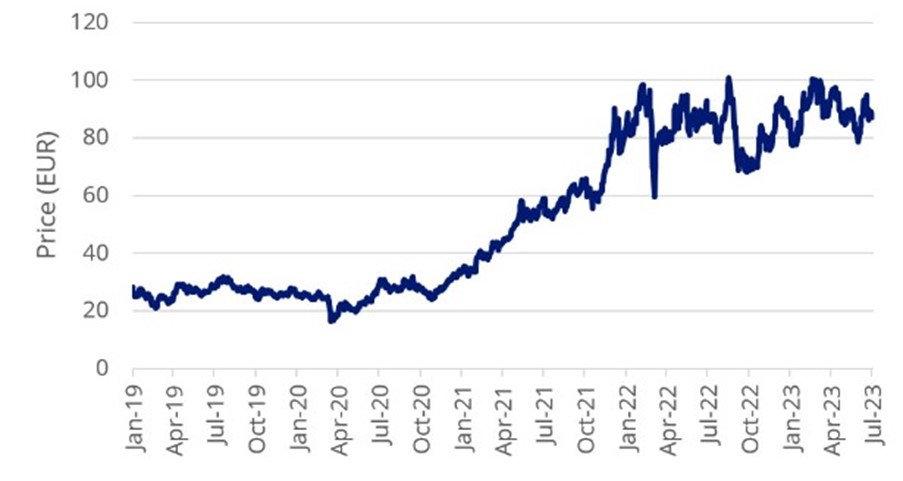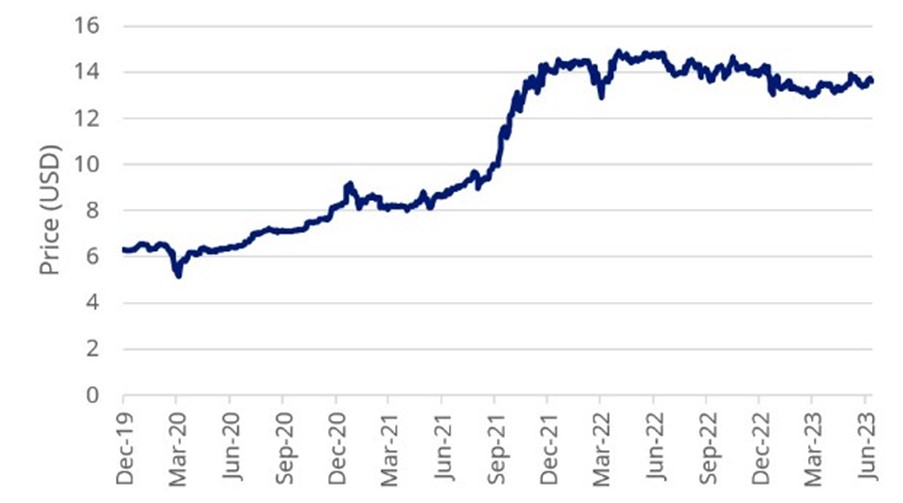Security Alert: Scam Text Messages
We’re aware that some nabtrade clients have received text messages claiming to be from [nabtrade securities], asking them to click a link to remove restrictions on their nabtrade account. Please be aware this is likely a scam. Do not click on any links in these messages. nabtrade will never ask you to click on a link via a text message to verify or unlock your account.
Carbon Markets: A Bullish Outlook for 2023
Carbon markets are increasingly seen as an essential part of efforts to reach net zero emissions by around 2050. We believe there is still asymmetric upside for the price of carbon, which remains at levels too low for global carbon targets.
There are two categories of carbon markets and it is important for investors to understand the difference. “Compliance” carbon markets are established, regulated markets that operate on a mandatory basis. By law, businesses must adhere to emissions limits set by the government and exceeding the limit requires the purchase of carbon credits so the business “pays” for their excess emissions.
The other category of carbon markets is “voluntary”, which is unregulated and operates, as the name suggests, on a voluntary basis whereby businesses can choose to offset their emissions by purchasing carbon credits. According to Reuters, the International Organization of Securities Commissions (IOSCO) says potential vulnerabilities in voluntary carbon markets include the lack of standardisation for measuring emissions, and concerns over quality and double counting of carbon credits, all of which could leave the sector open to fraud and manipulation. For these reasons, we believe the better investment opportunity lies within compliance markets.
The biggest of these compliance markets is the European Emissions Trading System (EU ETS). The price of polluting under this scheme hit a record high in February this year, with the December 2023 futures contract bursting through the key €100 threshold in response to new rules that will make it harder for EU polluters to buy allowances. The €100 price was considered important. According to a Reuters article at the time, “The 100-euro level has long been cited as a price that could incentivise some of the expensive technologies seen as necessary to limit global warming.”
Compliance carbon market schemes such as the EU ETS force manufacturers, power companies and airlines to pay for each tonne of carbon dioxide they emit as part of a country or region’s efforts to meet its climate targets. Compliance markets have grown rapidly, by 2021 they had an annual trading value of more than $900 billion, the EU ETS is by far the biggest accounting for about 90 per cent of trading volume and value for that year according to LSEG Carbon Research.
Meanwhile, authorities in the UK have just revealed the UK Emissions Trading Scheme will be reformed next year to tighten limits on carbon dioxide pollution and expanded in 2026 to include new sectors. The UK Emissions Trading System Authority has decided that industries covered by the scheme will need to bring down emissions at a faster rate to reach net zero goals. We believe changes to the scheme are a positive for carbon prices under the UK system going forward.
According to Reuters, this will lower the net-zero cap for Phase 1 to the top of the consulted range of 887-936 million UK allowances, the authority said. The current cap is 1,365 million, according to the consultation papers.
It also announced that the UK ETS will be extended to cover domestic maritime transport from 2026 and to cover waste from 2028, while a phased removal of free carbon allowances for the aviation industry will be rolled out in 2026.
While the European ETS is the oldest and biggest carbon trading scheme, the Regional Greenhouse Gas Initiative (RGGI) was the first ETS in the US and has grown to include eleven states. With supply and demand adjustments being finalised by the end of 2023, these are likely to be supportive for RGGI prices going forward.
Figure 1: European Union ETS Futures Price
 Source: ICE, June 2023. Past performance is not indicative of future performance.
Source: ICE, June 2023. Past performance is not indicative of future performance.
Figure 2: RGGI Futures Price
 Source: ICE, June 2023. Past performance is not indicative of future performance.
Source: ICE, June 2023. Past performance is not indicative of future performance.
2023 could be a vintage carbon year
We are bullish on the long-term outlook for carbon permit prices in compliance markets as they remain the policy tool of choice for incentivising abatement. Further the current environment could potentially be a compelling entry point as each of the four major markets has either recently increased its climate ambition or are expected to do so soon.
Elsewhere, Morgan Stanley takes a similar view, “We continue to see the case for structurally higher EUA carbon prices ahead to support the decarbonisation of industry. We consider this objective to be synonymous with energy security as much as climate action.” And CitiBank also note that, “despite a steepening contango of rising costs of carry, we continue to believe the market is underestimating the long-term EUA price.”
To achieve UN goals, being to limit global temperature increases to 1.5 degrees Celsius (ratified by the Paris Agreement), the International Monetary Fund and Organization for Economic Cooperation and Development report on tax policy and climate change has estimated that a carbon price of US$144 is needed by 20301. Currently, prices are not near that level.
BIOGRAPHY & DISCLAIMER FIELD
Alice Shen is a Senior Associate at VanEck. All prices and analysis at 11 July 2023. This information was produced by Alice Shen and published by Livewire Markets (ABN 24 112 294 649), which is an Australian Financial Services Licensee (Licence No. 286 531This material is intended to provide general advice only. It has been prepared without having regard to or taking into account any particular investor’s objectives, financial situation and/or needs. All investors should therefore consider the appropriateness of the advice, in light of their own objectives, financial situation and/or needs, before acting on the advice. This article does not reflect the views of WealthHub Securities Limited.
